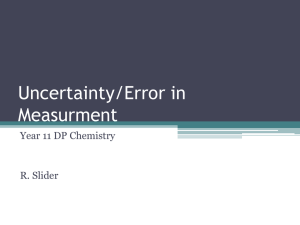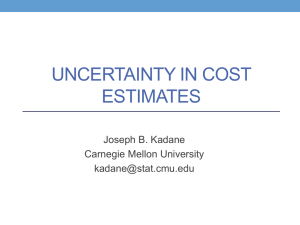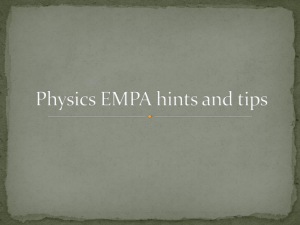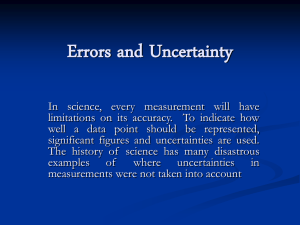GCE Physics
advertisement
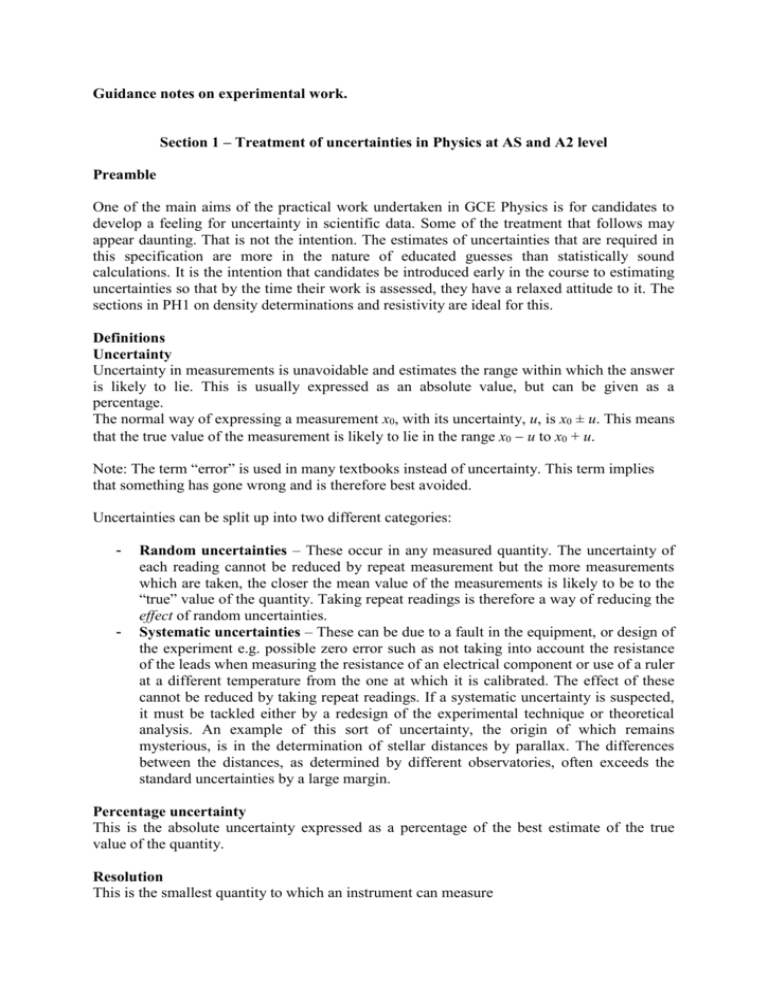
Guidance notes on experimental work. Section 1 – Treatment of uncertainties in Physics at AS and A2 level Preamble One of the main aims of the practical work undertaken in GCE Physics is for candidates to develop a feeling for uncertainty in scientific data. Some of the treatment that follows may appear daunting. That is not the intention. The estimates of uncertainties that are required in this specification are more in the nature of educated guesses than statistically sound calculations. It is the intention that candidates be introduced early in the course to estimating uncertainties so that by the time their work is assessed, they have a relaxed attitude to it. The sections in PH1 on density determinations and resistivity are ideal for this. Definitions Uncertainty Uncertainty in measurements is unavoidable and estimates the range within which the answer is likely to lie. This is usually expressed as an absolute value, but can be given as a percentage. The normal way of expressing a measurement x0, with its uncertainty, u, is x0 ± u. This means that the true value of the measurement is likely to lie in the range x0 u to x0 + u. Note: The term “error” is used in many textbooks instead of uncertainty. This term implies that something has gone wrong and is therefore best avoided. Uncertainties can be split up into two different categories: - - Random uncertainties – These occur in any measured quantity. The uncertainty of each reading cannot be reduced by repeat measurement but the more measurements which are taken, the closer the mean value of the measurements is likely to be to the “true” value of the quantity. Taking repeat readings is therefore a way of reducing the effect of random uncertainties. Systematic uncertainties – These can be due to a fault in the equipment, or design of the experiment e.g. possible zero error such as not taking into account the resistance of the leads when measuring the resistance of an electrical component or use of a ruler at a different temperature from the one at which it is calibrated. The effect of these cannot be reduced by taking repeat readings. If a systematic uncertainty is suspected, it must be tackled either by a redesign of the experimental technique or theoretical analysis. An example of this sort of uncertainty, the origin of which remains mysterious, is in the determination of stellar distances by parallax. The differences between the distances, as determined by different observatories, often exceeds the standard uncertainties by a large margin. Percentage uncertainty This is the absolute uncertainty expressed as a percentage of the best estimate of the true value of the quantity. Resolution This is the smallest quantity to which an instrument can measure Mistake This is the misreading of a scale or faulty equipment. Suspect results These are results that lie well outside the normal range e.g. points well away from a line or curve of best fit. They often arise from mistakes in measurement. These should be recorded and reason for discarding noted by the candidate. How is the uncertainty in the measurement of a quantity estimated? 1. Estimation of uncertainty using the spread of repeat readings. Suppose the value a quantity x is measured several times and a series of different values obtained: x1, x2, x3……..xn. [Normally, in our work, n will be a small number, say 3 or 5]. Unless there is reason to suspect that one of the results is seriously out [i.e. it is anomalous], the best estimate of the true value of x is the arithmetic mean of the readings: x1 x2 ........xn n A reasonable estimate of the uncertainty is ½ the range: Mean value x xmax xmin , where xmax is the maximum and xmin the minimum reading of 2 x [ignoring any anomalous readings] i.e. u Example The following results were obtained for the time it took for an object to roll down a slope. 4.5 s, 4.8 s, 4.6 s, 5.1 s, 5.0 s The best estimate of the true time is given by the mean which is: t 4.5 4.8 4.6 5.1 5.0 4.8s 5 The uncertainty, u, is given by: u 5.1 4.5 0.3s 2 The final answer and uncertainty should be quoted, with units, to the same no. of decimal places and the uncertainty to 1 sig. fig i.e. t = 4.8 ± 0.3 s Note that, even if the initial results had be taken to the nearest 0.01 s, i.e. the resolution of an electronic stopwatch, the final result would still be given to 0.1 s because the first significant figure in the uncertainty is in the first place after the decimal point. The percentage uncertainty, p 0.3 100% 6% . Again, p is only expressed to 1 s.f. 4.8 2. Estimation of uncertainty from a single reading Sometimes there may only be a single reading. Sometimes all the readings may be identical. Clearly it cannot be therefore assumed that there is zero uncertainty in the reading(s). With analogue instruments, it is not expected that interpolated readings will be taken between divisions (this is clearly not possible with digital instrument anyway). Hence, the uncertainty cannot be less than ½ the smallest division of the instrument being used, and is recommended it be taken to be ± the smallest division. In some cases, however, it will be larger than this due to other uncertainties such as reaction time [see later] and manufacturer’s uncertainties. If other sources of random uncertainty are present, it is expected that in most cases repeat readings would be taken and the uncertainty estimated from the spread as above. Advice for Specific apparatus Metre Rule Take the resolution as ±1 mm. This may be unduly pessimistic, especially if care is taken to avoid parallax errors. It should be remembered that all length measurements using rules actually involve two readings – one at each end – both of which are subject to uncertainty. In many cases the uncertainty may be greater than this due to the difficulty in measuring the required quantity, for example due to parallax or due to the speed needed to take the reading e.g. rebound of a ball, in which case the precision could be ± 1 cm. In cases involving transient readings, it is expected that repeats are taken rather than relying on a guess as to the uncertainty. Standard Masses For 20g, 50g, 100g masses the precision can be taken as being as being ±1g this is probably more accurate than the manufacturer’s [often about 3%]. Alternatively, if known, the manufacturer’s uncertainty can be used. Digital meters [ammeters/voltmeters] The uncertainty can be taken as being ± the smallest measurable division. Strictly this is often too accurate as manufacturers will quote as bigger uncertainty. [e.g. 2% + 2 divisions] Thermometers Standard -10 ºC to 110 ºC take precision as 1ºC Digital thermometers uncertainty could be ± 0.1ºC. However the actual uncertainty may be greater due to difficulty in reading a digital scale as an object is being heated or cooled, when the substance is not in thermal equilibrium with itself let alone with the thermometer.. The period of oscillation of a Pendulum/Spring The resolution of a stop watch, used for measuring a period, is usually 0.01s. Reaction time would increase the uncertainty and, although in making measurements on oscillating quantities it is possible to anticipate, the uncertainty derived from repeat readings is likely to be of the order of 0.1 s. To increase accuracy, often 10 (or 20) oscillations are measured. The absolute error in the period [i.e. time for a single oscillation] is then 1/10 (or 1/20 respectively) of the absolute error in the time for 10 (20) oscillations e.g. 20 oscillations: Time = 15.8 ± 0.1 s [0.6%] 15.8 0.1 Period s = 0.790 ± 0.005 s 20 Note that the percentage uncertainty, p, in the period is the same as that in the overall time. In this case, p 0.1 100% 0.6% (1 s.f.) 15.8 Digital vernier callipers/micrometer Precision smallest measurable quantity usually ± 0.01mm Measuring cylinder / beakers/ burette Smallest measurable quantity e.g. ± 1 cm³, but this depends upon the scale of the instrument. In the case of measuring the volume using the line on a beaker, the estimated uncertainty is likely to be much greater. Note candidates must be careful to avoid parallax when taking these measurements, and should state that all readings were taken at eye level. They should also measure to the bottom of the meniscus. Determining the uncertainties in derived quantities. Please note that candidates entered for AS award will now be required to combine percentage uncertainties. Very frequently in Physics, the values of two or more quantities are measured and then these are combined to determine another quantity; e.g. the density of a material is determined using the equation: m V To do this the mass, m, and the volume, V, are first measured. Each has its own estimated uncertainty and these must be combined to produce an estimated uncertainty in the density. The volume itself may have been determined by combining several independent quantity determinations [e.g. length, breadth and height for a rectangular solid or length and diameter for a cylindrical wire]. In most cases, quantities are combined either by multiplying or dividing and this will be considered first. Multiplying by a constant, squaring (e.g. in 34 r 3 ), square rooting or raising to some other power are special cases of this and will be considered next. 1. Multiplying and dividing: The percentage uncertainty in a quantity, formed when two or more quantities are combined by either multiplication or division, is the sum of the uncertainties in the quantities which are combined. Example The following results were obtained when measuring the surface area of a glass block with a 30cm rule, resolution 0.1cm Length = 9.7 ± 0.1 cm Width = 4.4 ± 0.1cm Note that these uncertainties are estimates from the resolution of the rule. This gives the following percentage errors: 0.1 100% 1.0% 9.7 0.1 Width pW 100% 2.2% 4.4 So the percentage error in the volume, pV 1.0 2.2 3.2% Hence surface area = 9.7 4.4 = 42.68 cm² ± 3.2 % The absolute error in the surface area is now 3.2% of 42.68 = 1.37 cm² Quoted to 1 sig. fig. the uncertainty becomes 1 cm² The correct result, then, is 43 ± 1cm² - Note that surface area is expressed to a number of significant figures which fits with the estimated uncertainty. Length: pL 2. Raising to a power (eg x2, x1, x) The percentage uncertainty in xn is n times the percentage uncertainty in x. e.g. a period (T) is as being 31 seconds with a percentage uncertainty of 2 %, So T2 = 961 ± 4%. 4% 961 = 40 (to 1.s.f) So the period is expressed as T = 960 ± 40 s. Note: x1 is the same as 1/x. So the percentage uncertainty in 1/x is the same as that in x. Can you see why we ignore the sign? Note: the percentage uncertainty in x is half the percentage uncertainty in x. 3. Multiplying by a constant In this case the percentage uncertainty is unchanged. So the percentage uncertainty in 3x or 0.5x or x is the same as that in x. Example: The following determinations were made in order to find the volume of a piece of wire: Diameter: d = 1.22 ± 0.02 mm Length: l = 9.6 ± 0.1 cm The percentage uncertainties are: pd = 1.6%; pl = 1.0%. Working in consistent units, and applying the equation V d2 4 l , we have: V = 448.9 mm3 The percentage uncertainty, pV = 1.6 2 + 1.0 = 4.2 % = 4 % (to 1 s.f.) [Note that and 4 have no uncertainties.] So the absolute uncertainty u = 448.9 0.04 = 17.956 = 20 (1 s.f.) So the volume is expressed as V = 450 ± 20 mm3. Multiply the percentage uncertainty 4. Adding or subtracting quantities [A2 only] If 2 quantities are added or subtracted the absolute uncertainty is added. This situation does not arise very frequently as most equations involve multiplication and division only. The e.m.f. / p.d. equation for a power supply is an exception. In all cases, when the final % uncertainty is calculated it can then be converted back to an absolute uncertainty and quoted 1 sig. figure. The final result and uncertainty should be quoted to the same number of decimal places Notes for purists: 1. When working at a high academic level, where many repeat measurements are taken, scientists often use “standard error” , a.k.a. “standard uncertainty”. Where this is used, the expression x0 ± is taken to mean that there is a 67% probability that the value of x is in the range x0 to x0 + , a 95% probability that it lies in the range x0 2 to x0 + 2, a 98% probability that it is between x0 3 and x0 + 3, etc. Our work on uncertainties will not involve this high-level approach. 2. The method which we use here of estimating the uncertainty in an individual quantity takes no account of the number of readings. This is because it is expected that only a small number of readings will be taken. Detailed derivation of standard uncertainties (see above) involves taking the standard deviation of the readings and then dividing this by n 1 , so taking 10 readings would involve dividing by 3. 3. The above method of combining uncertainties has the merit of simplicity but it is unduly pessimistic. If several quantities are combined, it is unlikely that the actual error (sic) in all of them is in the same direction, i.e. all + or all . Hence adding the percentage uncertainties overestimates the likely uncertainty in the combination. More advanced work involves adding uncertainties in quadrature: i.e. p p12 p2 2 p32 ...... . This is normally done when standard uncertainties are employed (note 1 above). It is not intended that candidates pursue any of these courses! GRAPHS [derivation of uncertainties from graphs is only expected in A2] The following remarks apply to linear graphs: The points should be plotted with error bars. These should be centred on the plotted point and have a length equal to ymax ymin [for uncertainties in the y values of the points]. If identical results are obtained the precision of the instrument could be used. If the error bars are too small to plot this should be stated. If calculating a quantity such as gradient or intercept the steepest line and a least steep line should be drawn which are consistent with the error bars. It is often convenient to plot the centroid of the points to help this process. This is the point x, y , the mean x value against the mean y value. The steepest and least steep lines should both pass through this point. . The maximum and minimum gradients, mmax and mmin, [or intercepts, cmax and cmin] can now be found and the results quoted as: mmax mmin mmax mmin 2 2 cmax cmin cmax cmin intercept = 2 2 gradient = Scales Graph should cover more than ½ of the graph paper available and awkward scales [e.g. multiples of 3] should be avoided. Rotation of the paper through /4 [90 !] may be employed to give better coverage of the graph paper. Semi-log and log-log graphs [A2 only] Students will be expected to be familiar with plotting these graphs as follows: Semi-log: to investigate relationships of the form: y ka x . Taking logs: log y log k x log a or ln y ln k x ln a [It doesn’t matter which] So a plot of log y against x has a gradient log a and an intercept log k . Examples: Radioactive or capacitor decay, oscillation damping Log-log: to investigate relationships of the form: y Axn Taking logs: log y log A n log x [or the equivalent with natural logs] So a plot of log y against log x has a gradient n and an intercept log A . Examples: Cantilever depression or oscillation period as a function of overhang length, Gallilean moon periods against orbital radius to test relationship. Note that Log-log or semi-log graph paper will not be required. Uncertainties from Log graphs: Candidates will not be expected to include error bars in log plots. Section 2 – Ideas for practical work Prac Density of regular solids [cuboids, cylinders] Identification of material using density. Context Use of metre rule, callipers, micrometer, balance Initial work on uncertainties Density of liquids and irregular solids Use of measuring cylinders Weighing a rule by balancing a loaded rule Use of P of M Acceleration of a trolley on a ramp [lots of Use of equations of motion – graphs to variants here] determine acceleration Determination of g by simple pendulum N.B. Not on spec but a useful intro to oscillation period measurements Investigation of a compound pendulum or a Ditto pin and pendulum I-V characteristics of diodes, lamps etc. Use of ammeters, voltmeters, variable resistors, potentiometers [pots]. Identification of the material of a wire by Various ways – single measurements / R determination of its resistivity against l. Uncertainty combinations. Variation of resistance with temperature for a Thermistor not on spec but it doesn’t matter metal wire [copper is good] and/or thermistor here. Could tie in with potential dividers to design a temperature sensor. Determination of resistance of a voltmeter by ! use of a series resistor. Investigation of currents in series and parallel circuits Determination of internal resistance of a Direct use of V = E Ir or use of power supply 1 1 r - use of reciprocals in graphical V E ER work. Sonometer – variation of frequency with Use of reciprocals in graphical work length – determination of the speed of transverse waves on the metal wire Measurement of the wavelength of microwaves by standing waves Measurement of the wavelength of microwaves by Double slit (or Lloyd’s mirror) Measurement of wavelength of a laser by Young’s slits Measurement of wavelength of a laser pointer using a diffraction grating Measurement of refractive index of glass or water by real and apparent depth Measure refractive index of a semicircular glass block using ray box [or pins!] Measurement of the speed of sound in air using a double beam CRO and two microphones Section 3 – Experimental techniques The following is a selection of experimental techniques which it is anticipated that candidates will acquire during their AS and A2 studies. It is not exhaustive, but is intended to provide some guidance into the expectations of the PH3 and PH6 experimental tasks. Measuring instruments The use of the following in the context of individual experiments: micrometers and callipers. These may be analogue or digital. It is intended that candidates will have experience of the use of these instruments with a discrimination of at least 0.01 mm. A typical use is the determination of the diameter of a wire. digital top-loading balances. measuring cylinders and burettes. This is largely in the context of volume and density determination. force meters (Newton meters). stop watches with a discrimination of 0.01 s. It is also convenient to use stopwatches / clocks with a discrimination of 1 s. rules with a discrimination of 1 mm. digital multimeters with voltage, current and resistance ranges. The following (d.c.) ranges and discriminations illustrative the ones which are likely to be useful: 2V 0.001 V 20 V 0.01 V 10 A 0.01 A 2A 0.001 A 2 k 1 200 0.01 Students should be familiar with the technique of starting readings on a high range to protect the instrument. liquid in glass thermometers. -10 110C will normally suffice, though candidates can be usefully introduced to the advantages of restricted range thermometers. Where appropriate, digital temperature probes may be used. Experimental techniques The purpose of PH3 is to test the ability of the candidates to make and interpret measurements, with special emphasis on: combining measurements to determine derived values, eg density or internal resistance estimating the uncertainty in measured and derived quantities investigating the relationships between variables These abilities will be developed by centres, using all the content of PH1 and PH2. They can and will be assessed using very simple apparatus which can be made available in multiple quantities. Hence it is not foreseen that apparatus which centres are likely to possess in small numbers, if at all, will be specified, e.g. oscilloscopes, data loggers, travelling microscopes. The following list may be found useful as a checklist. Candidates should be familiar with the following techniques: connecting voltmeters across the p.d. to be determined, i.e. in parallel; connecting ammeters so that the current flows through them, i.e. in series; the need to avoid having power supplies in circuits when a resistance meter is being employed; taking measurements of diameter at various places along a wire / cylinder and taking pairs of such measurements at right angles to allow for non-circular cross sections; determining a small distance measurement, e.g. the thickness or diameter of an object, by placing a number of identical objects in contact and measuring the combined value, e.g. measuring the diameter of steel spheres by placing 5 in line and measuring the extent of the 5; the use of potentiometers (N.B. not metre wire potentiometers) and variable resistors in circuits when investigating current-voltage characteristics; the determination of the period and frequency of an oscillating object by determining the time taken for a number of cycles [typically 10 or 20]; N.B. Although the concept of period is not on the AS part of the specification, it is likely to be used in PH3; the use of fiducial marks and no-parallax in sighting against scales and in period determinations.



